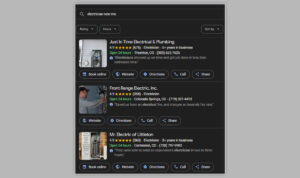Creating a landing page for affiliate marketing is a key step to boost your sales and commissions.
These pages are specially crafted to turn visitors into buyers, making them vital for both affiliates and the main brand.
In this guide, we’ll walk you through the essential steps and best practices to make your landing page as effective as possible.

-
Table of Contents
Key Takeaways
Understanding the Purpose of an Affiliate Marketing Landing Page
Choosing the Right Design Tool for Your Landing Page
Popular Design Tools for Landing Pages
Pros and Cons of Different Tools
How to Choose the Best Tool for Your Needs
Crafting a Compelling Headline and Hook
Elements of a Strong Headline
How to Write a Captivating Hook
Examples of Effective Headlines
Incorporating Strong Visual Elements
Writing Concise and Persuasive Copy
Tips for Writing Clear Copy
Common Mistakes to Avoid
Examples of Persuasive Copy
Integrating Clear and Compelling CTAs
What Makes a CTA Effective?
Placement of CTAs
A/B Testing Your CTAs
Using Social Proof to Boost Credibility
Optimizing for Mobile Users
Importance of Mobile Optimization
Tips for Mobile-Friendly Design
Common Pitfalls to Avoid
Testing and Analyzing Your Landing Page
Why Testing is Crucial
Tools for Analyzing Performance
How to Interpret Data and Make Improvements
Avoiding Common Pitfalls in Landing Page Design
Overloading with Information
Ignoring Page Load Speed
Neglecting User Experience
Keeping Your Landing Page Updated
Why Regular Updates are Important
How to Keep Content Fresh
Monitoring Trends and Adapting
Conclusion
Frequently Asked Questions
What is an affiliate marketing landing page?
Why do affiliates need landing pages?
Can I use more than one CTA on an affiliate landing page?
What are some types of affiliate landing pages?
How do I create a compelling headline for a landing page?
Why are visuals important on a landing page?
What makes a CTA effective?
Why is mobile optimization important for landing pages?
Key Takeaways
-
Choose the right design tool to create your landing page, considering both its features and your needs.
-
Write a strong headline and hook to grab attention and keep visitors engaged.
-
Use compelling visuals to make your landing page more engaging and appealing.
-
Include clear and persuasive copy to guide visitors towards taking action.
-
Regularly test and update your landing page to keep it effective and relevant.
Understanding the Purpose of an Affiliate Marketing Landing Page
An affiliate marketing landing page is a standalone page designed to convert visitors into customers or leads through focused content and clear call-to-action.
Its main goal is to drive conversions, which leads to commissions for affiliates and sales for the primary brand.
This makes the process rewarding for both parties involved.
Here is a landing page I created for the FractalMax Newsletter and VIP community campaign.
Lead conversion on cold traffic 40% and 52% on warm traffic.

Choosing the Right Design Tool for Your Landing Page
Creating a landing page for affiliate marketing doesn’t require coding skills. There are many design tools available that make the process simple and effective.
Choosing the right tool is crucial for building a successful landing page.
Popular Design Tools for Landing Pages
There are several popular tools you can use to design your landing page. Some of the most commonly used ones include:
-
Unbounce: Known for its drag-and-drop editor and variety of templates.
-
Leadpages: Offers easy integration with other marketing tools.
-
ClickFunnels: Great for creating sales funnels and landing pages.
-
Instapage: Provides advanced A/B testing features.
Pros and Cons of Different Tools
Each tool has its own strengths and weaknesses. Here’s a quick comparison:
How to Choose the Best Tool for Your Needs
When selecting a design tool, consider the following factors:
-
Ease of Use: Make sure the tool is user-friendly.
-
Template Quality: Look for a variety of high-quality templates.
-
Integration: Ensure it integrates well with your other marketing tools.
-
Cost: Choose a tool that fits your budget.
-
Customer Support: Good support can be very helpful.

Crafting a Compelling Headline and Hook
Elements of a Strong Headline
Your headline needs to grab the reader’s attention and make them want to learn more.
It should encourage them to keep reading or scrolling so you can draw them toward your CTA.
Your headline is what will keep visitors from clicking out of your landing page right away.
How to Write a Captivating Hook
A good hook can make all the difference. It should generate curiosity, intrigue, or even a sense of urgency.
Think about what makes your product or service unique and use that to your advantage.
Examples of Effective Headlines
Here are some examples of strong headlines:
-
“Earn Big with Our Top-Rated Affiliate Program – Start Making Money Today!”
-
“Discover the Secret to Effortless Weight Loss – Join Our Program Now!”
-
“Unlock Exclusive Deals – Sign Up for Free Today!”

Incorporating Strong Visual Elements
Visuals play a crucial role in enhancing user experience, communicating your message, and driving conversions.
Many studies show that people remember 80% of what they see, only 20% of what they read, and 10% of what they hear.
In today’s scenario, when people are bombarded with information, visuals are an effective way to break through clutter and grab their attention.
Writing Concise and Persuasive Copy
Tips for Writing Clear Copy
Your copy should be clear and to the point. Focus on a single idea in each section or paragraph.
This helps keep your readers engaged and makes your message easier to understand.
Avoid using fancy words or drama; instead, be authentic and straightforward. Show your audience how your product solves their problem.
Common Mistakes to Avoid
-
Too Short or Too Long: If your copy is too short, you might not convey your benefits effectively. If it’s too long, you risk losing your audience’s attention.
-
Overloading Information: Don’t overwhelm your readers with too much information. Keep it simple and relevant.
-
Ignoring the Audience: Make sure your copy resonates with your audience. Speak their language and address their needs.
Examples of Persuasive Copy
-
“Secure your spot for the free training and discover how to boost your affiliate marketing income.”
-
“Unlock the secrets to successful affiliate marketing with our step-by-step guide.”
-
“Join our community of successful marketers and start earning today!”
Integrating Clear and Compelling CTAs
What Makes a CTA Effective?
A strong call-to-action (CTA) is essential for guiding your visitors to take the next step.
Make your CTA buttons stand out visually by using contrasting colors and action-oriented text like “Sign Up Today” or “Get Instant Access.”
Ensure the CTA is easy to find and click.
Placement of CTAs
Position your CTA buttons strategically throughout the page. Follow the natural reading flow and place CTAs where they are most likely to be seen.
For example, you can place a CTA at the end of a compelling section or near a testimonial.
Below you can see a clear call to action: “Download Your Free Ebook”.

A/B Testing Your CTAs
Experiment with different versions of your CTAs through A/B testing to find out what works best.
Test various elements like text, color, and placement.
This will help you fine-tune the details and maximize conversions.
Analyzing data on micro-conversions can provide invaluable insights for further optimization.
Using Social Proof to Boost Credibility
Social proof is a powerful tool in affiliate marketing. When potential customers see that others trust a product, they are more likely to trust it too.
This can include testimonials, reviews, or endorsements from satisfied users. Here are some effective types of social proof you can use:
-
Customer Testimonials: Share stories from real customers who have benefited from the product. This helps build trust.
-
User Reviews: Display ratings and reviews from users to show the product’s popularity and effectiveness.
-
Expert Endorsements: If an expert or influencer recommends the product, it can significantly boost credibility.
To make the most of social proof, consider the following:
-
Diverse Opinions: Show a variety of testimonials to give a well-rounded view of the product.
-
Visuals: Use images or videos of real customers using the product to create a personal connection.
-
Highlight Results: Focus on the positive outcomes that customers have experienced.
By effectively incorporating social proof into your landing page, you can enhance trust and encourage more conversions.
It’s especially important in affiliate marketing, where potential buyers often look for recommendations from trusted sources.
Optimizing for Mobile Users
Importance of Mobile Optimization
Given that 58.67% of global web traffic comes from mobile devices (according Statista), making sure your page is mobile-friendly is crucial.
This means your page should look great and work well on different devices, screen sizes, and browsers.
Fast loading speed is another key factor; aim to have your page load in under 3 seconds by compressing images, minifying CSS and JavaScript, and using content delivery networks (CDNs) to improve speed.

Tips for Mobile-Friendly Design
-
Responsive Design: Ensure your landing page adjusts smoothly to different screen sizes.
-
Simple Navigation: Make it easy for users to find what they need quickly.
-
Readable Text: Use larger fonts and enough spacing to make reading easy.
-
Fast Loading: Compress images and use efficient coding to speed up your page.
-
Touch-Friendly Buttons: Make sure buttons are big enough to tap easily.
Common Pitfalls to Avoid
-
Overloading with Information: Too much text can overwhelm users. Keep it concise.
-
Ignoring Page Load Speed: Heavy visuals can slow down your page. Resize and compress images before using them.
-
Neglecting User Experience: Always test your page on different devices to ensure a smooth experience.
By following these tips, you can improve the user experience for mobile visitors and potentially increase conversion rates from this audience.

Testing and Analyzing Your Landing Page
Why Testing is Crucial
Testing your landing page is essential to understand what works and what doesn’t. It helps you make data-driven decisions to improve your page’s performance.
Without testing, you might miss out on opportunities to increase conversions and optimize user experience.
This was the beginning of an ad campaign I ran for FractalMax Newsletter and VIP community.

Tools for Analyzing Performance
There are several tools available to help you analyze your landing page’s performance.
Some popular options include:
-
Google Analytics
-
Hotjar
-
Crazy Egg
-
Optimizely
These tools provide insights into user behavior, helping you identify areas for improvement.
How to Interpret Data and Make Improvements
Once you have collected data, it’s time to interpret it and make necessary changes. Look for patterns and trends in user behavior.
For example, if users are leaving your page quickly, you might need to improve your content or design.
A/B testing is a great way to compare different versions of your page and see which one performs better.

Avoiding Common Pitfalls in Landing Page Design
Overloading with Information
A landing page should be clear and to the point. Too much information can overwhelm visitors and make them leave.
Focus on the key message and keep it simple. Avoid clutter and unnecessary details.
Ignoring Page Load Speed
Page load speed is crucial. If your page takes too long to load, visitors will leave before they even see your content.
Compress images and use efficient coding to ensure fast load times.

Neglecting User Experience
User experience is everything. Make sure your landing page is easy to navigate and visually appealing.
Avoid distractions like pop-ups and ads. A clean, simple design works best.
Keeping Your Landing Page Updated
Why Regular Updates are Important
Regular updates to your landing page are crucial for maintaining its effectiveness. A stale page can turn visitors away and hurt your conversion rates.
By keeping your content fresh, you ensure that your page remains relevant and engaging to your audience.
How to Keep Content Fresh
-
Monitor Trends: Stay updated with the latest trends in affiliate marketing and incorporate them into your landing page.
-
Update Visuals: Refresh images and videos to keep the page visually appealing.
-
Revise Copy: Regularly review and update the text to ensure it remains persuasive and clear.
-
Test New Ideas: Experiment with different headlines, hooks, and CTAs to see what works best.
Monitoring Trends and Adapting
Keeping an eye on industry trends is essential. This helps you adapt your landing page to meet the changing needs and preferences of your audience.
Use tools like Google Trends and social media to stay informed. By doing so, you can make timely updates that keep your page competitive.
Keeping your landing page fresh is key to attracting and retaining visitors.
Regular updates not only improve user experience but also boost your site’s search engine ranking.
Visit our site to learn how you can start you own affiliate business in 7 days. Turn-key system DFY.
Conclusion
Creating a successful landing page for affiliate marketing is all about balancing creativity with strategy. Remember to keep your design clean and your message clear.
Use strong visuals and compelling headlines to grab attention, and don’t forget to include social proof to build trust.
Always keep your audience in mind and test different elements to see what works best.
By following these tips, you’ll be well on your way to boosting your conversions and making your affiliate marketing efforts more rewarding. Happy marketing!
Frequently Asked Questions
What is an affiliate marketing landing page?
An affiliate marketing landing page is a web page designed specifically to promote affiliate products and drive conversions. It aims to persuade visitors to take a specific action, such as making a purchase or signing up for a newsletter.
Why do affiliates need landing pages?
Affiliates need landing pages to boost conversion rates and effectively promote products. A well-crafted landing page can attract and engage visitors, leading to higher commissions for affiliates.
Can I use more than one CTA on an affiliate landing page?
Yes, you can use more than one Call-To-Action (CTA) on an affiliate landing page. However, it’s important to ensure that each CTA is clear and doesn’t confuse the visitors.
What are some types of affiliate landing pages?
Some types of affiliate landing pages include lead capture pages, squeeze pages, click-through pages, splash pages, microsites, sales pages, viral landing pages, and infomercials.
How do I create a compelling headline for a landing page?
To create a compelling headline, focus on making it clear, concise, and attention-grabbing. Use strong words and address the needs or interests of your target audience.
Why are visuals important on a landing page?
Visuals are important because they engage visitors, make the content more appealing, and help convey the message quickly. Good visuals can also build trust and credibility.
What makes a CTA effective?
An effective CTA is clear, concise, and compelling. It should prompt visitors to take a specific action and be strategically placed on the landing page for maximum visibility.
Why is mobile optimization important for landing pages?
Mobile optimization is important because a significant number of users access websites through mobile devices. Ensuring your landing page is mobile-friendly improves user experience and increases the chances of conversions.
Source: fractalmax.agency



